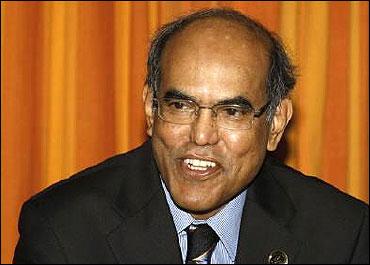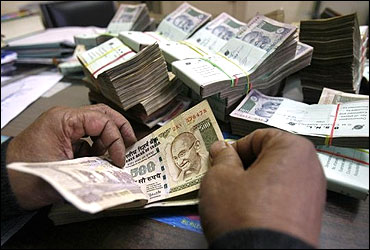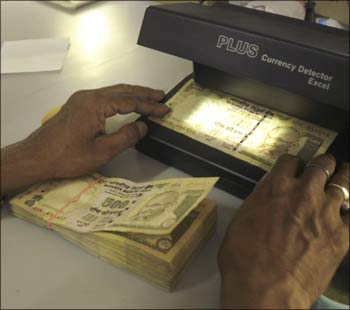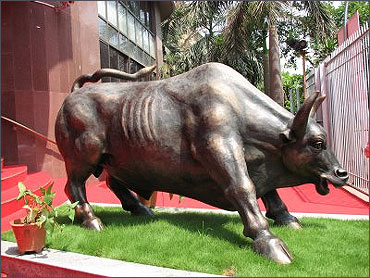Photographs: Punit Paranjpe/Reuters
The Reserve Bank of India on Tuesday chose to continue with its tight monetary stance and raised interest rates by 25 basis points -- 13th time since March, 2010-- to tame inflation, even as it lowered the growth target to 7.6 per cent for the current fiscal.
In a major policy decision, Reserve Bank Governor Duvvuri Subbarao also deregulated savings bank deposit rates with immediate effect.
. . .
Bad News! RBI hikes rates by another 25 bps
Image: A bank teller counting money.Photographs: Reuters
Here are the highlights:
- Short-term lending (repo) rate up by 25 bps to 8.5 pc
- Savings bank deposit rate freed; depositors to benefit
- To remove prepayment penalty on home loans
- Lowers GDP forecast to 7.6% for FY 2012 from 8%
- Says inflation to ease from December; gives a projection of 7 per cent by March-end
- Food inflation likely to remain under pressure
- Hints at pause in policy; may not hike rate further
- Short term borrowing rate (reverse-repo) kept at 7.5%
- Retains cash reserve ratio at 6%
- Says global situation poses downside risk to GDP
- Weak rupee offsetting benefits of easing commodity rates
- Warns of private investment being crowded out by higher government borrowing
- Next monetary policy review on December 16
. . .
Bad News! RBI hikes rates by another 25 bps
Image: A man stands next to the logo of the Reserve Bank of India.Photographs: Reuters
"Changing the policy stance when inflation is still far above the tolerance level entails risks to the credibility of the Reserve Bank of India's commitment to low and stable inflation," the policy document said, even as it admits that growth
momentum has slowed down.
It said inflation will start cooling by December this year and is likely to come down to 7 per cent by March, 2012.
Tuesday's hike is the 13th since March 2010.
The series of rate hikes has cumulatively increased interest rates by 525 basis points.
. . .
Bad News! RBI hikes rates by another 25 bps
The policy is expected 'to continue to anchor medium term inflation expectations', while stimulating investment activity
to support growth.
Borrowers, who are livid at repeated rate hikes, can heave a sigh of relief as the RBI hinted at a reversal of policy stance by saying the likelihood of a hike in December is 'relatively low'.
. . .
Bad News! RBI hikes rates by another 25 bps
The Reserve Bank of India has kept other key rate and ratio -- bank rate and cash reserve ratio -- unchanged at 6 per cent each.
It also retained the statutory liquidity ratio at 24 per cent.
Factors like weakening global macroeconomic outlook and high domestic inflation will pull down the economic growth rate further, RBI said while lowering the GDP forecast for the current fiscal to 7.6 per cent from its earlier projection of 8 per cent.
The risks to the policy emanate from worsening global macro scenario, commodity prices and increase in government spending which could crowd out private investment, it said.
. . .
Bad News! RBI hikes rates by another 25 bps
Image: The bull.Photographs: Reuters
The Reserve Bank has also proposed to notify banning prepayment penalty on floating rate home loans, as recommended by the Banking Ombudsman recently.
The policy document further said that RBI will issue the final guidelines on credit default swaps by November-end.
As banking system prepares to go on to the Basel-III framework requiring higher capital adequacy, the RBI said the draft guidelines for its implementation will be issued by December-end.
As regards the micro finance sector, RBI has given the go-ahead for creating a new category called NBFC-MFIs (NBFC-Micro finance Institutions).
. . .
Bad News! RBI hikes rates by another 25 bps
An important policy decision RBI announced on Tuesday is the freeing of savings bank deposit rates with immediate effect, the last bastion of the regulated interest rate regime.
Earlier in May, RBI had raised the savings deposit rates to 4 per cent from 3.5 per cent.
Giving banks the freedom to fix the savings accounts interest rate, RBI said banks will have to offer uniform rate on deposits of up to Rs 100,000.
On higher amounts, they can give differential rates to depositors.
It has also permitted commercial banks to open branches in tier II cities without prior approval of RBI.








article